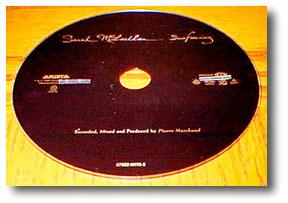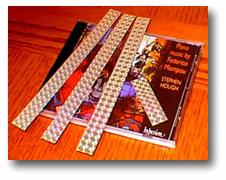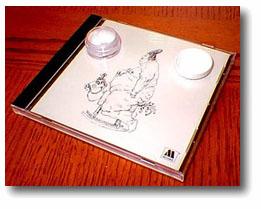![[SoundStage!]](../sslogo3.gif) Synergizing with Greg Weaver Synergizing with Greg WeaverBack Issue Article |
| July 1999 Foil Follow-Up and the Cream Electret The saga rages on...
I have to tell you that the "Itty Bitty Foil" is now considered required equipment on all CD playback here these days. To borrow a phrase from Synergizer Lou who wrote me last month, "if it spins, Foil it!" I have found that using two 5mm-by-15mm strips per disc, one each placed radially from center to edge, situated at the 90- and 270-degree marks (the 3 and 9 o’clock positions for those who are geometrically challenged) seems to provide the maximum enhancement (see photo below left). I’m not inferring that they HAVE to be placed at those two adjacent positions to provide the best performance, just that placing them in a straight line, 180 degrees opposite on the disc, seems to work best. This particular placement arrangement MAY have something to do with the dynamic balance of the disc, but I’m not absolutely sure that this is the only contributing factor. These two positions also just seem to be natural spots to allow a pseudo-linear placement, yet don’t mask any of the vital printed info on most discs. Use of more than two strips doesn’t seem to offer any greater sonic benefit in my trials, and one just isn’t quite as good as two.
Enter the foil. Wow! The CD now sounds like a sonic spectacular in comparison to the untreated disc. Cymbals have a restored vividness, vocals are rendered with much more life and flavor, and the space of the recording seems magically developed. Not that the disc is now flawless. I’m not suggesting that the foil magically repairs the faults with the recording, just that the level of enhancement seems magical. The same thing holds true of my favorite Doobie Brothers work, The Captain and Me [Warner 2694]. I had always had similar feelings about this 1973 masterpiece; it just seemed distant and dull. Post foiling, the work has taken on a new life, as if some new breath had been infused into the performance and recording. The foil seems to remove some hazing or veiling that is not even noticed until it is removed. This stuff is completely indispensable in my opinion. And it would seem that your opinions on the results of the foil application vary as widely as do my listening results. Some of you wrote that, for all your trying, you found it to have NO BENEFIT whatsoever. One reader even proclaimed that I had "lost all credibility" and that he was "deeply disappointed" in me. He pronounced the whole thing a scam. By the same token, many, many more of you wrote to thank me for letting you in on this pleasant surprise and for sharing so freely such valuable information. One person wrote to say that even his wife, who had barely noticed when he had added a subwoofer to his system, was readily able to tell the difference. Yet another thanked me for "taking the high ground" and "turning him on" to this remarkable tweak. More people used words like "amazing" and "unbelievable" in their messages on this subject than in response to any other column I’ve offered here. All I can say to those of you who tried it and found it to offer little to no benefit in your system is thank you for giving it a go. And hey, a huge thanks to May Belt’s hospitality, as the Foil cost nothing to investigate. Yet, so many readers found it to be such an effective application that they feel as I now do -- that it is a necessory rather than an accessory. One reader has brought to light one factor that he found crucial to divining results from using the foil. I am offering it here as it may have some impact on the results of those of you who didn’t find the foil application to be very significant. He informed me that he had spent about two weeks messing with the foil and was nearly about to give up when he decided to give it one last try. He donned headphones and listened to the classical tracks from the Sheffield/XLO burn-in and test disc both with and without the foil. Voilá, there was the difference that I had described and which had eluded him to that point. In his tests, classical and jazz instruments sounded far more realistic with the foil. Though he found the differences to be quantifiably small, he found them to be quite significant aurally. It would seem that his initial tests had been done with techno discs, consisting of electronically generated and heavily sampled material. He feels this made it quite difficult to hear the differences with and without the foil, as he would have no real idea (based on live experience) what the instruments should sound like. His switch to traditional instruments provided him with a means of comparing the recorded sounds of the instruments with what they really sounded like, based on his own live listening experience. He also felt that the move to headphones allowed him to pick up more detail, noting that his system just didn't provide him with the same degree of resolution. Many, including our own Doug Blackburn, feel that equally beneficial results could be achieved by the use of other similar materials, like Mylar tape for example. Perhaps. But I’ve been too busy with other matters to really go into this. If you have done so, or care to, be sure to post me with what you find out. And one last note for thought. Guess what, Synergizers? The Foil performs the same magic on DVDs. Stay tuned for more on that front. Voodoo goo
Having had so much luck with the CD medium when experimenting with the foil, it only seemed natural to go to those shiny little devils for my first foray into mystically anointing my music. This time, as there would be no way to undo the application, I had to rely exclusively on duplicate copies of source material. One of the oldest discs in my arsenal of demo material is James Newton Howard and Friends [Sheffield Labs CD 23], and it is a disc that I had in triplicate -- with one still sealed! Playing the two open copies assured me that there were no appreciable differences in their overall timbre, balance and presentation, so I immediately went to smearing one lightly with the cream. The instructions recommend using your finger or a cloth, but never a paper cloth like a tissue, and to treat both label and optical sides of the disc. My decades of photo processing had left me with a penchant for getting my hands on the subject, so I dunked my right forefinger into the jar and wiped off a bit of the cream. I applied it to both sides of the disc, per the instructions, then, with a soft cotton cloth, wiped off the excess. The treatment had seemed to leave an opaque film on the disc that would seem to be difficult for the player to read through. In went the control disc and I reacquainted myself with two of my favorite tracks, "Caesar" and "She." Queuing the same tracks on the treated "milky" disc brought a surprise. I couldn’t believe it. There was more shimmer on cymbals and slightly better decay. Bass was weightier -- and slightly tauter. I could now hear a little more deeply into the presentation and pick up slightly more detail. There was a bit more substance to instrument locations. The disc seemed just a bit louder -- or was that an illusory artifact of greater dynamic contrasts? Yes, that was it. As Artie Johnson’s German-soldier character on the old Rowan & Martin’s Laugh In used to quip, "Verrrrrrry interesting!" Next up was the double-header on the same gold disc of For Duke by Bill Berry & his Ellington All-Stars, and Fatha by Earl "Fatha" Hines [M&K RealTime RM 5001]. The first cut, "Take the ‘A’ Train," was again much better handled on the treated disc. The presentation was a bit wider and better focused. Cymbals had more bite and "bronze" flavoring, while the woodwinds were more reedy-sounding. I want to stress that all the observations I made above were slight -- easily noticed, but slight nonetheless. The cream, while indeed working its magic, did not offer the same degree of change mustered by the foiling, but it really did work as advertised. My first thoughts were that the resultant characteristic changes in the sound might have something to do with the surface treatment of the disc, an effect I discussed at length in November of 1997 with "Hyper Shiny Software Treatments". But I have to admit that at this point my curiosity was piqued by thoughts of what it might do with vinyl. Now, I don’t mind telling you that I have great reservation about smearing my precious black pies with anything, let alone some white pasty alchemy cream. So digging into my duplicate reserves, I found two records so nearly matched in pedigree and not so valuable as to be perfect for my initial trials, Steely Dan’s Greatest Hits [ABC AK-1107-2]. Both records were of nearly the same vintage, judging by their stamper numbers -- D7 and D8. And both were the handiwork of mastering engineer extraordinaire Robert Ludwig, bearing the Masterdisk stamp and his distinguishing RL initials. Playing side four on both pies indicated that my reading of the matrix numbers in the run-out groove had proved quite accurate, as they sounded virtually indistinguishable from one another. The instructions announce that you should ONLY apply the cream to the label area, on both sides, of the record and not to the vinyl itself. I had NO TROUBLE with that notion, so smear-away I did. Once I had wiped the excess cream from both labels, it was time for what I was sure would be a dead heat. I was wrong. On "Kid Charlemagne" the treated album offered a much more "live" display. Vocals were less strident and more alive. Stage depth, width and focus were heightened. The keyboard was more vivid in its harmonic richness, less hollow-sounding overall. The most remarkable manifestation was that of the space and decay of the backing vocalists and the hall acoustic, which became more pronounced and apparent. On "Peg," there was an increase to the warmth of the cymbals, and a slightly better presentation of them. They were re-created further apart and layered better in their location. Bass, while seemingly lower in volume, was more taut and controlled. The slightest unveiling on tracks became more apparent with longer listening and more applications. Now, I should tell you that the instructions go into treating the furniture in your room, your CD jewel boxes and album jackets, the underside of the covers of your equipment, fuses, batteries in your remotes, faces of clocks, and so on. And of course things directly related to playback, like your tonearm, cartridge body, record clamp, platter and plinth of your turntable. While I admit to complete skepticism here, I honestly didn’t have enough of the stuff to go out on that limb. If you research this aspect of the product, write me and let me know what you heard. I had been prepared, once again, to find that this "metaphysical" gel had NO EFFECT on my music. I must admit that I was once again wrong and pleasantly surprised. What this voodoo goo did to my beloved analog medium, while admittedly only slight by quantifiable standards, was exceptionally pleasing and moved the recreation of the live event a step closer to that high standard. The differences are small in the numerical realm, yet on the musical side of the equation, they are quite rewarding. It would appear that the foil works its legerdemain much better on CDs and that the cream performs its wizardry to higher effect on vinyl. To me, $32 represents about two CDs, about one and a quarter new vinyl releases, or maybe as many as six or eight pre-owned records. Weird how I think, eh? While I have no idea how many records the 15 centiliter jar will treat, I can say that if your analog playback system is your passion and of high enough resolving power, the results are very musical and, to me, well worth the investment. ...Greg Weaver
|
|
![[SoundStage!]](../sslogo3.gif) All Contents All ContentsCopyright © 1999 SoundStage! All Rights Reserved |
 Well, the volume
of messages received about your results with the PWB Rainbow Electret Foil here at
Synergizing Central over the past months has been tremendous. So many of you took
advantage of May Belt’s gracious free offer (over 450 and still counting) that I have
hardly had time to do anything other than answer your letters. I hope you all took
advantage of this unprecedented offer -- and thanked Mrs. Belt for her generosity.
What’s that? You didn’t try it? Well, good news. Via a recent correspondence
with May, she was kind enough to inform me that she has extended the free-sample offer to
all Synergizers, so write her at
Well, the volume
of messages received about your results with the PWB Rainbow Electret Foil here at
Synergizing Central over the past months has been tremendous. So many of you took
advantage of May Belt’s gracious free offer (over 450 and still counting) that I have
hardly had time to do anything other than answer your letters. I hope you all took
advantage of this unprecedented offer -- and thanked Mrs. Belt for her generosity.
What’s that? You didn’t try it? Well, good news. Via a recent correspondence
with May, she was kind enough to inform me that she has extended the free-sample offer to
all Synergizers, so write her at  I have noticed widely varying
degrees of change wrought to music, with no real particular rhyme or reason. The greatest
consistency to the range of improvement seems to be experienced on older and seemingly
more poorly recorded material. From the first time I played Kansas’ second album,
Song For America, [on Kirshner (need I say more!) 2K 33385] back in 1975, I have been
in love with it. Such use of orchestration from a rock band was previously unrealized in
my experience. Their utilization of symphonic tone-poem-like material, complete with
recurring phrases (try "Lamplight Symphony" or "Incomundro – Hymn to
the Atman") and thematic reprise throughout the work, with such underlying power and
an electric violin, just struck a chord for me. I always wished that they had taken more
care in the recording process, as Song just left something to be desired from the
sonic aspect.
I have noticed widely varying
degrees of change wrought to music, with no real particular rhyme or reason. The greatest
consistency to the range of improvement seems to be experienced on older and seemingly
more poorly recorded material. From the first time I played Kansas’ second album,
Song For America, [on Kirshner (need I say more!) 2K 33385] back in 1975, I have been
in love with it. Such use of orchestration from a rock band was previously unrealized in
my experience. Their utilization of symphonic tone-poem-like material, complete with
recurring phrases (try "Lamplight Symphony" or "Incomundro – Hymn to
the Atman") and thematic reprise throughout the work, with such underlying power and
an electric violin, just struck a chord for me. I always wished that they had taken more
care in the recording process, as Song just left something to be desired from the
sonic aspect. Well, a micro-sized jar of
Cream Electret arrived shortly after the appearance of the first article in April, and I
was equally put off when I saw it. The jar measures just 1 1/8" in diameter and
5/8" tall -- with the cap on! Now, as my jar was a sample, there was just a dab of
the precious cream in its micro repository. The directions indicated that since the cream
is difficult to manufacture, it likely would remain fairly expensive for some time. Right
now, a 15 centiliter jar sells for twenty pounds, or about $32. It was further explained
that the cream is an emulsification of oil and water, is non-toxic and
"polarized."
Well, a micro-sized jar of
Cream Electret arrived shortly after the appearance of the first article in April, and I
was equally put off when I saw it. The jar measures just 1 1/8" in diameter and
5/8" tall -- with the cap on! Now, as my jar was a sample, there was just a dab of
the precious cream in its micro repository. The directions indicated that since the cream
is difficult to manufacture, it likely would remain fairly expensive for some time. Right
now, a 15 centiliter jar sells for twenty pounds, or about $32. It was further explained
that the cream is an emulsification of oil and water, is non-toxic and
"polarized."